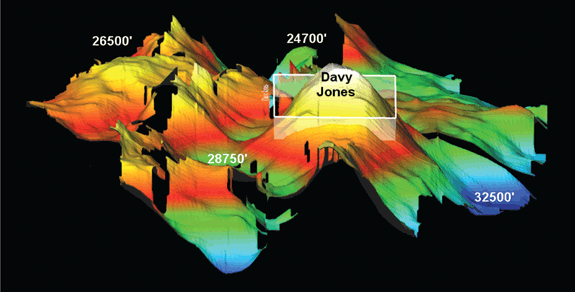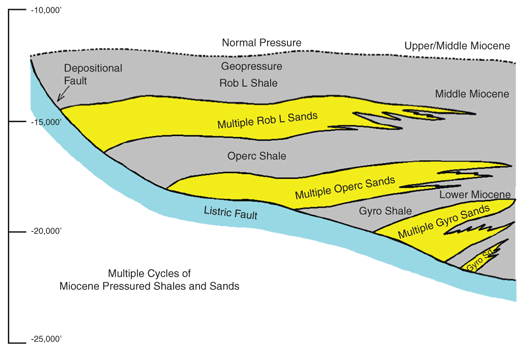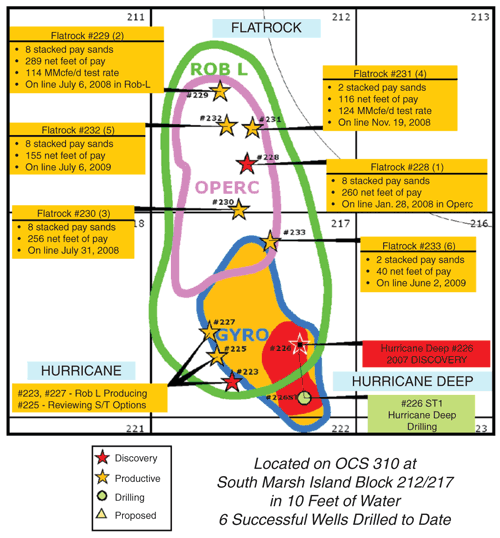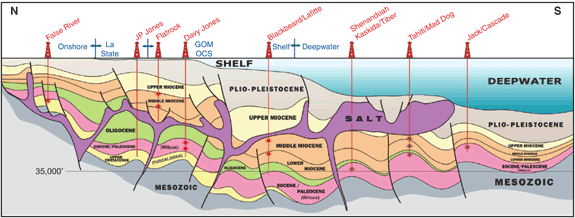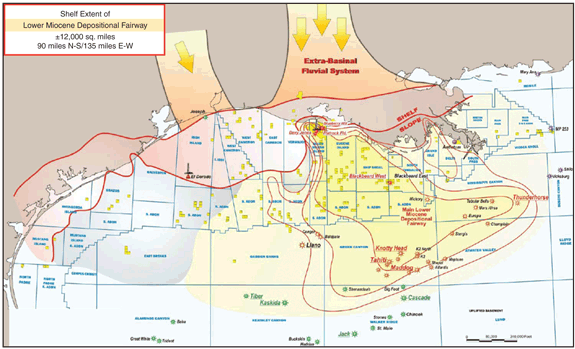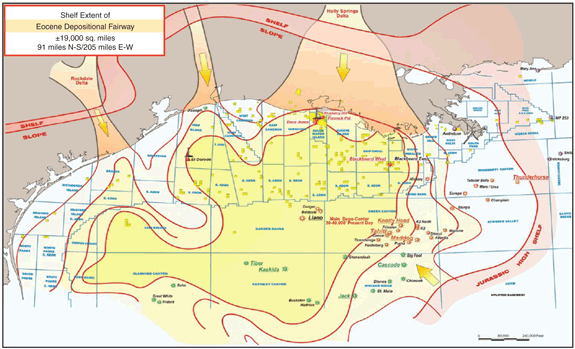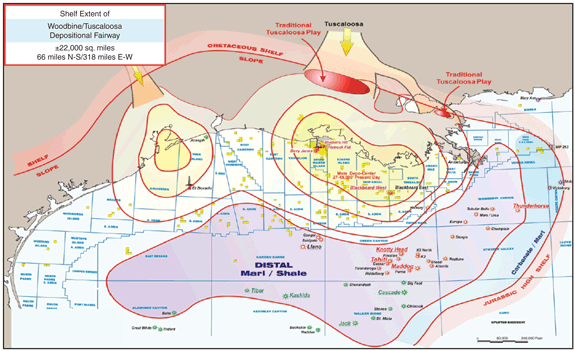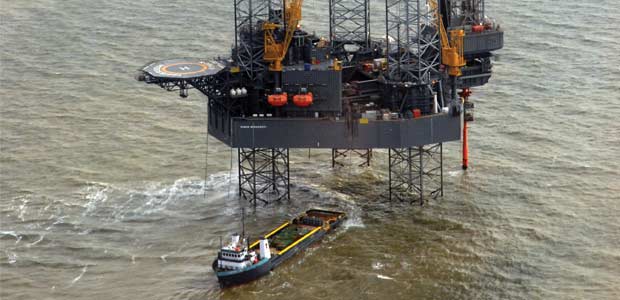
Davy Jones Discovery Opening New Shelf Frontier In Ultradeep Geology Below Salt
By Tim Beims
NEW ORLEANS–In maritime lore, Davy Jones presides over the spirits of the briny deep. For McMoRan Exploration Co., Davy Jones could be the gate keeper to a new exploration frontier at subsurface depths that only a handful of brave souls have dared ever penetrate with a drill bit on the Gulf of Mexico Outer Continental Shelf.
The lure of the ultradeep is a vast potential natural gas deposit locked in structures below the salt weld that cuts through Gulf Coast sediment layers. And if McMoRan’s hypothesis on ultradeep geology proves correct, the below-salt resource potential at depths of 25,000-35,000 feet could wind the clock back to another era, when rank wildcat drilling was commonplace in shallow-water blocks.
“Davy Jones has the potential to be a mega discovery; possibly the largest discovery on the Shelf in decades,” maintains James R. “Jim Bob” Moffett, McMoRan’s co-chairman of the board. “Seismic imaging shows a huge, uniform structure below the salt weld that covers four lease blocks. If flow testing and development drilling confirm our predictions, we expect reserves in the multiple-trillion cubic foot range.”
On June 28, 2009, Rowan’s Mississippi jackup re-entered an old abandoned well bore that had been drilled to the top of the salt at 19,958 feet to spud Davy Jones in 20 feet of water at South Marsh Island Block 230. After nearly seven months of drilling, the bore hole extended five and a half miles into the seafloor, where according to Moffett, pipe-conveyed wireline logs run to 28,530 feet indicated 200 feet of net pay in six Wilcox sands deposited during the late Paleocene.
“The Wilcox sands logged below 27,300 feet appear to be of exceptional quality with porosity between 12 and 22 percent,” he says. “Although flow testing is required to confirm the ultimate hydrocarbon rates, all the hydrocarbon zones were full to base.”
McMoRan has deepened the discovery well–located 10 miles off the Louisiana coast–from a measured depth of 28,603 feet to a total depth of 29,122 feet to evaluate additional Wilcox sections before flow testing the well later this year or early next year. “This is brand new territory,” Moffett declares. “Flow testing is the next challenge. No one has ever tried to flow a well at the combined temperatures and pressures we have at Davy Jones.”
Noting that reservoir temperatures exceeding 440 degrees Fahrenheit require tools and equipment purpose-engineered to take the heat, and that the bottom-hole pressure regime is ±27,000 psi, Moffett exclaims, “That is four times the pressure it takes to launch a spaceship into orbit!”
As operator, McMoRan holds a 32.7 percent working interest in the Davy Jones discovery. Partners include Plains Exploration & Production Company, Energy XXI, Nippon Oil Exploration USA and W.A. “Tex” Moncrief Jr.
Seeing The Big Picture
Everything about Davy Jones is eye-popping: from the drilling depth to the size of the reservoir complex, to the extreme pressures and temperatures. But even though its size could rival giant deepwater fields, Moffett insists that the biggest thing about the discovery is what it means to deep-horizon geology and future Gulf activity.
“In geology, you have to put together lots of little pieces and connect the dots to see the big picture, which is what I have tried to do with our deeper pool concept. We started looking with seismic to find structures deeper than conventional Shelf fields–first above salt and now below it,” he relates. “If you do not understand the big picture, you cannot possibly understand the ultradeep play.”
Although geologically complex, he says McMoRan’s big-picture theory is actually fairly straightforward. Discoveries have established that Miocene and Wilcox/Lower Tertiary sands are productive both onshore and in deep water. In order to reach deepwater blocks hundreds of miles offshore, Moffett contends, the sands had to travel across the Shelf during deposition, which means they should also be present somewhere in the shallow-water subsurface horizon.
That somewhere is the virtually unexplored geologic realm below salt on the Shelf, according to Moffett. The first wells McMoRan drilled to test its theory were Blackbeard West in 2008 and Davy Jones in 2009-10, both of which targeted structures below salt. Blackbeard West confirmed Miocene sands below 30,000 feet, while Davy Jones confirmed Wilcox sands below 27,000 feet.
The results, he says, underscore the “oneness” of Gulf Coast geology, with the same telltale structural and stratigraphic markers stretching from onshore to ultradeep water. “One of the biggest misconceptions is that the Shelf and deep water are separate geologic provinces. They are different engineering provinces, but once you get below the salt weld, it is one continuous basin,” Moffett contends. “There is no ‘state line’ dividing the geology. It is the same.”
In effect, Davy Jones and Blackbeard West “connect the dots” in the ultradeep Shelf between the Miocene and Lower Tertiary reservoirs that operators have drilled for years on land and structures of the same geologic age that are being found in deep water, Moffett states. And that is exactly as it should be, according to the geologic model that the McMoRan team has developed on the structural setting below salt.
“Success to date was derived from the combination of McMoRan’s deeper pool model and contributions from the Three Musketeers’ ultradeep model,” Moffett says, explaining that the Three Musketeers, as he has nicknamed them, are geoscientists Randol Haworth, Jay Menard and Glen Denyer. All three have been proponents of the ultradeep geologic model for more than a decade, he says, and joined McMoRan in 2007 through its $1.1 billion acquisition of Newfield Exploration Company’s Shelf properties.
“Davy Jones and Blackbeard West are the missing links between onshore and deep water. This missing ultradeep Shelf information ties the onshore and deep water, and in our opinion, proves this is all one basin. We can see the footprint of the Miocene and Wilcox across the Gulf,” Moffett remarks. “The data from these two wells confirm our original geologic modeling, which correlates the objective sections on the Shelf below the salt weld in Miocene and older sections to productive sections in deep water.”
And with more ultradeep Shelf wells scheduled to spud this year, he says McMoRan expects to continue to fill in the picture of the ultradeep with new information from drilling as well as flow tests of Davy Jones and Blackbeard West. “These wells are redefining the subsurface contour below salt,” Moffett holds. “The results will be incorporated into our model as we continue to define the potential of this promising new exploration frontier.”
Different Kind Of DNA
Acknowledging that it takes “a different kind of DNA” to drill multimillion-dollar wildcats to test the merits of a new interpretation of the geology underlying a producing province considered mature, Moffett says ultradeep exploration requires specialized knowledge and skill sets, along with a good bit of nerve.
“If you have not been in high-pressure drilling or spent time looking at data on deeper pool structures, frankly, you are like a goat looking at a new gate,” he posits. “Drilling these wells and evaluating these sands is a whole new ballgame, and there is no way to learn it overnight. The only way to get there is by living through some of the experiences and knowing how to react to situations.”
With no analogue data from nearby offsets, Moffett adds that the mentality it takes to drill to uncharted depths with unknown temperatures and pressures harkens back to his college years, and an adage often repeated by hall-of-famer Darrell Royal, the former football coach at the University of Texas at Austin, where Moffett was a two-year letterman: Winners never quit and quitters never win.
“The margin between a dry hole and a discovery is sometimes almost inexplicable,” he suggests. “You have to keep your spirit. It is a business where those who have succeeded have enough moxie, courage and perseverance to turn their failures into successes.”
Davy Jones represents a subsalt extension to McMoRan’s history of deep gas successes above the salt weld on the Shelf, including the Flatrock, Hurricane, Hurricane Deep, JB Mountain and Mound Point discoveries. “The goal of our deeper pool concept was to find deep structures, but not with 3-D bright spot techniques because we were too deep for bright spot detection to be effective,” Moffett says. “We had to develop a geologic model to guide exploration.”
The risk profile of drilling to 19,000 feet with solid geologic correlations is one thing, he indicates, but hitting the top of the salt and then turning the bit another 10,000 feet with no corollary within a 100-mile radius is quite another. “We were confident in our model, but Davy Jones pushed the envelope much farther even than Flatrock (McMoRan’s 2007 discovery at 18,000-19,000 feet, where it now has drilled six wells producing a combined 300 million cubic feet a day). At least we had tie-ins to discoveries on strike with Flatrock and could see analogue sands,” Moffett states.
“We could not do that at Davy Jones,” he goes on. “If you go north, you have a completely different Wilcox sand facies. It is a very silty, dirty sand, almost like the Yegua above it. When you go south, the only Wilcox sands are those that have been drilled in deep water.”
After interpretation on regional-scale 2-D seismic data, Moffett says McMoRan imaged the Davy Jones structure with reprocessed prestacked time- and depth-migrated 3-D data acquired by Fairfield, using long-offset ZNodal™ seafloor acquisition technology.
“Davy Jones looks like a majestic mountain peak on 3-D seismic (Figure 1). When I look at it, I think about the Grasberg discovery (the world’s largest gold mine and third largest copper mine), which Freeport-McMoRan made in New Guinea in 1988. Like Davy Jones, we had no geology and one small mine two miles away as the only analogue,” Moffett remembers.
“Some people thought that even if we did find something in New Guinea, we would never be able to develop it,” he adds. “There, we were at 13,000 feet in the middle of nowhere with no infrastructure, and here we are 29,000 feet with nearby infrastructure, but the challenge is being able to produce the reserves.”
Unexplored Ultradeep
In contrast to the deep gas play, where drilling targets are above salt at depths of 15,000-25,000 feet, the focus of the ultradeep play is on structures deeper than 25,000 feet and beneath salt. And while deep gas prospects target reserves in the hundreds of billions of cubic feet range, Moffett says ultradeep Shelf prospects hold reserves in excess of 1 Tcf in deeply buried structures with geologic analogues to deepwater finds.
“Both plays are in shallow water with lots of infrastructure to allow rapid development, but the reserves are much bigger in the ultradeep play because the structures are so much bigger,” he notes.
The shallow-water Gulf may be one of the most heavily drilled offshore areas the world over, but Moffett emphasizes that of the more than 48,000 wells on the Shelf, only 1 percent (532) have been drilled to depths between 18,000 and 25,000 feet. And, he points out, the ultradeep Shelf is even more untouched, with seven well bores penetrating beyond 25,000 feet.
“The Shelf is one of the largest, most mature and hydrocarbon-rich provinces in the world, but it is almost completely unexplored below 25,000 feet,” he declares. “Exploration has stopped at the top of the salt.”
Throughout much of the deepwater Gulf, the Plio-Pleistocene sediment layer thins and the salt becomes much thicker and closer to the seafloor, resulting in little above-salt geology to explore, Moffett points out. On the Shelf, however, he says an abundance of Plio-Pleistocene and Miocene targets delineated by bright spot amplitude anomalies have historically left little incentive to image or drill below salt, as has been the case in deep water.
“Bright spot detection was the best exploration tool I have seen. Independents bought old shallow-water platforms to sharpshoot the bright spots,” he recalls. “That game was played big time, but it was all above salt and those targets are gone.”
Another factor, Moffett says, was the impact of heaving shales (or “suitcase shales,” as he dubs them) on exploration and drilling operations. A dominant feature of Gulf Coast geology, these sections of anomalously pressured hydrating shale absorb water, swell and slough into the bore hole, leading to pipe sticking, excessive solids buildup in the mud, hole bridging and other drilling hazards.
“Suitcase shales are a big reason why drilling depths moved in steps and stopped at the top of the salt,” he claims. “The industry eventually figured out there were series of shale/sand sequences stacked on top of one another, with tongues of high-pressured shales encasing geopressured gas sands to create perfect pressure traps as you go deeper.”
Figure 2 shows McMoRan’s above-salt Miocene depositional model for offshore Louisiana, with multiple cycles of pressured shales and geopressured sands. “Above the salt, the play is 50 percent stratigraphy and 50 percent structure,” Moffett explains. “You have to have enough guts to back off the tops of some of these structures and go down almost adjacent to the depositional faults, because the sands are too thin if you drill the ‘sucker fault line’ on top of the structure. This became our model above the salt weld and for the so-called trapdoor faults that are so prevalent in the Miocene.”
The Flatrock discovery in 10 feet of water at South Marsh Island 212/217 provides an example of the above-salt depositional model, Moffett relates. “We drilled a couple wells on top of the structure (in the area marked “Gyro” in Figure 3) that found 50 Bcf-60 Bcf of reserves,” he recalls. “But when we went downdip, we caught the big sands and got 300 Bcf-400 Bcf wells that flow tested at more than 100 MMcf a day.”
Modeling The Ultradeep
Building on its string of deep gas discoveries, McMoRan now is taking exploration below the salt where Moffett says it is betting on finding even larger structures with reserves comparable to deepwater discoveries. Figure 4 shows the company’s geologic model of the ultradeep Shelf. The salt weld is shown in purple, overlying the Miocene, Wilcox/Lower Tertiary and Tuscaloosa.
“I call the salt weld the dancing dragon. Above it, the geology is very different. But below it, the geology is the same from onshore to deep water,” Moffett observes.
That model was strengthened by the high-profile deepwater Thunderhorse, which hit Miocene sands in fold belt-type compressional tectonics. “We were astounded because it was the biostratigraphic equivalent of the Miocene reserves we were finding above the salt on the Shelf, all of them affected by trap-door tectonics,” Moffett states.
Another key Miocene data point is Blackbeard West in 70 feet of water at South Timbalier Block 168, Moffett notes. McMoRan assumed operatorship of the well in 2007 after acquiring Newfield’s Shelf assets. Originally operated by ExxonMobil with partners Newfield, BP, Petrobras, Dominion and BHP Billiton, the well was abandoned in September 2006 short of its targeted depth.
“There was a lot of concern that the pressures were too great to drill the well deeper than 30,000 feet or so. We were able to re-enter the well and deepen it to 32,997 feet to find Miocene sands, but we then put things on hold to await the outcome of Davy Jones so we could confirm the Wilcox section,” he reveals. “While we have not yet tested Blackbeard West, it gives us an important Miocene tie to onshore and deep water.”
Blackbeard West, and Davy Jones after it, also help recalibrate subsalt stratigraphic depths. Fifteen years ago, as deepwater activity was taking off, the assumption was that the Miocene went to 40,000 feet on the Shelf, Moffett says. “We called it the Terrebonne Trough,” he notes. “Probably one of the biggest things these wells have done is redefine Miocene and Wilcox depths. Davy Jones, for example, intersected the Wilcox (below the Miocene) at 26,000 feet, which is 15,000-20,000 feet shallower than once thought.”
Depositional History
Rethinking the Gulf’s depositional history is fundamental to McMoRan’s view of the ultradeep structural setting. “The one thing geologists and geophysicists can take away from our depositional modeling is that Gulf geology is far more complex and interrelated than anyone imagined,” Moffett offers.
Figure 5 is McMoRan’s model of Lower Miocene deposition, spanning 12,000 square miles. “Since the beginning of time, the Mississippi River has been draining two-thirds of the United States and depositing sediments in the Gulf, creating a slope across the Shelf. The industry assumed this always would be normal or trapdoor faulting,” remarks Moffett.
But then the Thunderhorse discovery showed that the Miocene fold belt could extend under salt into deep water. “We realized this sand had piled in on the source side from the Mississippi River, with the Yucatan creating a ‘push back’ to create folds caused by the compression of continually dumping sand,” he details. “The huge deposit of Miocene sands covers a large area.”
The real surprise, however, is the Wilcox/Lower Tertiary, according to Moffett. Figure 6 shows a conceptual model of Eocene/Paleocene depositional fairways. Deposited earlier than the Miocene with the same Mississippi River source channel, the Wilcox appears to have twice the geographic footprint. What explains the considerably wider dispersion pattern?
“No one had any idea the Wilcox covered this kind of area. What has been missed, in my opinion, is that there was much shallower water in the Gulf during the time the Wilcox sediment load came in,” he offers. “Because the water was shallower, Wilcox sands fanned out over a massive area.”
Considering what may have caused such dramatic change in Gulf geomorphology led McMoRan to a singular event that likely had catastrophic consequences: the impact of a six-mile wide meteorite striking at Chicxulub on the Yucatan Peninsula, 65 million years ago, Moffett suggests.
“The Wilcox sits on the Cretaceous/Tertiary boundary in geologic time. Just before the Wilcox was deposited, the meteorite hit and created unmitigated hell, probably killing the dinosaurs. You can bet there was a tremendous impact that caused earthquakes all over the world and probably led to a giant tsunami that washed the water out of the Gulf,” he theorizes. “We think the Gulf became a very shallow basin. In fact, I am not sure there was more than 1,000 feet of water for a long time.”
Onshore, Wilcox and Yegua sands tend to be silty and poorly-sorted, Moffett continues. “When you get into the pressured section, you also encounter high temperatures. For instance, temperatures reach more than 450 degrees in the Wilcox at the Fandango Field in Zapata County, Tx.,” he notes. “But it is a different story offshore. If you look at the resistivity and gamma ray data from Davy Jones, you would say these are some of the cleanest and highest-quality Wilcox sands ever seen in the Gulf.”
Another surprise in the ultradeep Shelf, according to Moffett, may be the presence of the Cretaceous-aged Woodbine/Tuscaloosa, a prolific deep-sand package onshore (Figure 7). “As interesting as Davy Jones is in regard to the Wilcox, following analogues in the data, we expect to find a Tuscaloosa trend in the ultradeep Shelf. It probably will cover a much smaller area because Cretaceous sands were deposited before the meteorite hit, but it should be significantly larger than the Tuscaloosa trend onshore,” he surmises. “And that is saying something because that was one heck of a trend.”
Back To The Future
According to Moffett, the Davy Jones structure covers 20,000 acres and appears on seismic to be a classic four-way closure. That is telling, he says, because four-way traps are a common denominator among discoveries with at least 500 Bcfe of reserves both offshore on the Louisiana Shelf and onshore South Louisiana.
“There are a lot of four-way closures–more than two dozen of these big piles of sand on four-way closures–just to the north of the salt weld below the Shelf,” Moffett states. “Every one of those fields was drilled between the 1930s and 1960s.”
Jumping across the Shelf into deep water, Moffett says four-way closures are being discovered from Thunderhorse in Mississippi Canyon, to Tahiti and Knotty Head in Green Canyon, to the Lower Tertiary/Wilcox finds at Walker Ridge, Keathley Canyon and Alaminos Canyon. “We have a complete trend,” he holds. “There are now more than 40 of these giant four- and three-way closures against salt. We had all these discoveries onshore, and we now are seeing four-way closures in deep water.”
Labeling the Miocene, Wilcox and Tuscaloosa as “big-ticket items,” Moffett reiterates that like the onshore and deep water, large structures with four-way closures below salt on the Shelf appear to cover enough area to hold major reserves. “When you are looking at multiple-Tcf reserves, these structures could flow 1 Bcf or more a day, and they are in the middle of Shelf infrastructure,” he says. “We are going back to the 1940s and ’50s, when this series of big four-way closures was drilled onshore. These ultradeep Shelf structures will get drilled, I can tell you that.”
That is the good news. The bad news is that the prospects will have to be drilled with heavy-duty rigs and heavy mud weights, and logged and completed with HP/HT-rated equipment the likes of which the Gulf has never seen, Moffett goes on. “For example, conventional logging tools will not work with these temperatures and pressures,” he points out. “We probably spent three months trying to get good logs on Davy Jones.”
Rigs with the mechanical capacities to safely drill ultradeep wells are another issue. “You need a derrick with a hook load capacity of at least 2 million pounds to set the intermediate casing string between 16,000 and 18,000 feet. We have two of the three rigs in the Gulf with sufficient hook load capacity to drill these wells (Rowan’s Mississippi and Ralph Coffman jackups),” Moffett reports. “We have a commitment on the third rig (also owned by Rowan), and will put it to work later this year. If the ultradeep play catches on like we think, a lot of contractors will be upgrading their rigs.”
Once total depth is reached, a conventional jackup with a day rate of $40,000-$50,000 can move on location to run tubing and conduct completion operations, rather than using an ultradeep-rated rig at $150,000-$200,000 a day, Moffett points out.
Davy Jones Well Test
The immediate future of the ultradeep play rides largely on the results of the Davy Jones well test, Moffett poses. “From the logs, it looks like we have clean sheet sands as opposed to turbidite channel and levy sands. In fact, we probably are looking at sheet sands throughout the entire Shelf and deepwater Wilcox embayment,” he offers. “That is what it looks like right now, but again, we have only a few Wilcox data points, and the nearest Wilcox flow test is a long way to the south (the deepwater Jack well). There could be some surprise faults that we cannot see with geophysics.”
Two key issues that well testing will help resolve are the anticipated reserves recovery factor and the reservoir drainage area. “Because of the lateral continuity of sheet sands, we hope to be able to pull a lot of gas through the reservoir,” Moffett remarks. “With no major structural barriers or stratigraphic separation, a well put on production at one point of the reservoir should generate a pressure response at the other end. The big four-way reservoirs I have studied above the salt weld are that connected, and what we have seen below salt in deep water seems similar.”
Moffett reports that the timing of the well test depends on the hardware’s required pressure rating. “We are doing diagnostics to determine whether we can use 20,000 psi test equipment such as safety valves, wellhead trees, casing and tubing,” he updates. “There must be enough metal that if we have to shut in the well, the iron will not split and lead to a well out of control. It is serious business, and like everything we are doing in this pioneering effort, we want to make sure we have it right. If we have to go with 25,000 psi test equipment, it may be the fourth quarter before it gets delivered.”
The well test data acquired at Davy Jones will frame the blueprint for the Wilcox across the ultradeep trend. “Whatever works in one block should work in other blocks, as long as the depth is similar,” Moffett says. “Once pressure and temperature information is acquired on a couple wells, we will have the specifications for a standard equipment design.”
Noting that the equipment used in shallower sections is obsolete in ultradeep wells, Moffett says, “Not only are exploration companies interested in the play, but service companies know there is demand for the technology and they are anxious to build it–whether it is wireline tools, drilling mud, production equipment, or logging services. We are talking about a play that could require entirely new types of equipment. We have had a lot of inquiries, and probably 75 percent are from companies specializing in HP/HT equipment and services.”
Ultradeep Inventory
After flow testing Davy Jones, McMoRan eventually will turn its attention to testing Blackbeard West. “We think we have some big reserves sitting there,” Moffett says. “But while one or two wells can prove up a structure, until we get two or three more prospects drilled, there is no way to have complete confidence in correlating sands from one area to another to prove our geologic theory.”
Accordingly, Moffett says McMoRan has multiple prospects lined up in its ultradeep inventory that are slated to begin drilling this year, including an appraisal at Davy Jones, deepening Blackbeard West, and exploration wells at Blackbeard East, Lafitte and John Paul Jones, in addition to deep-gas prospects at Blueberry Hill in Louisiana state waters and Hurricane Deep at South Marsh Island 217.
“We so far have had only Blackbeard West and Davy Jones, located 85 miles apart with one downdip on the Miocene trend and the other on the Wilcox trend. It is challenging, to say the least, to make predictions and correlations from seismic, even though we feel very comfortable because our ties have worked out,” he avers.
“When we get all three rigs on location, we expect to drill the Davy Jones confirmation well, Lafitte and Blackbeard East at the same time. That will give us three new data points at once,” Moffett says. “Every foot we drill will impact offset acreage and correlations across the play.”
The Davy Jones appraisal is two-and-a-half miles southwest of the discovery well, and will test the same sections (Figure 8), with positive results supporting the existence of continuous reservoir sands, Moffett analyzes. John Paul Jones is located in 10 feet of water, 10 miles northeast of Davy Jones. Like Lafitte, it also is on trend with the Wilcox and Tuscaloosa, he says.
“As with Davy Jones, these are large anticlinal structures below salt with synclines between them. If one proves to be as good as we hope, then all the other prospects are on strike with the same objective sections. The multiple effect of proving up one structure will make the other prospects less risky,” he contends, noting that drilling on Blackbeard East kicked off in March. “We expect to encounter a similar section to Blackbeard West, but with more Miocene sands because of the geometry of the salt.”
New Opportunities
For the time being, McMoRan has the ultradeep Shelf market cornered, but Moffett says he expects that to change as majors and other independents jump in. “Many Shelf leases are held by production from old wells in Plio-Pleistocene and Miocene formations above salt,” he observes. “Those wells are depleting, and once a lease goes off production, the operator has six months to get it back. The operators already own the deep rights, so I expect they will make every effort to get deep wells drilled and return leases to the held-by-production category.”
In fact, he notes that McMoRan acquired the rights to the Davy Jones acreage through farm-ins with majors and independents that held the four lease blocks by virtue of shallow production. “Companies that own huge portfolios of Shelf acreage are very interested in this play, which should create farm-in opportunities,” Moffett holds. “All kinds of partnership opportunities are going to get looked at again.”
In the meantime, Moffett says McMoRan will focus on continuing to “fill in the blanks” in ultradeep Shelf geology one well at a time. “We are encouraged by what we see, but we know there is still a lot to learn,” he comments. “I am focusing on getting the Davy Jones exploration well evaluated and the offset drilled, and getting other ultradeep prospects started. We are trying to absorb what we have done so far and keep moving forward to prove up the play.”
Considering that McMoRan has identified more than a dozen prospects of similar size with the same geologic corollaries, could Davy Jones eventually prove the first in a series of big payoffs in the ultradeep Shelf?
“Because these structures are so large, it is easy to get excited. But if, as we believe, Davy Jones has sheet sands that cover the entire structure, the gas is to the base of the Wilcox sands and we can get normal recoveries out of it, we are looking at a multiple-Tcf discovery,” Moffett concludes. “What that would mean to McMoRan is significant reserve additions. Davy Jones alone would add to our reserve base multifold. It could be huge.”
For other great articles about exploration, drilling, completions and production, subscribe to The American Oil & Gas Reporter and bookmark www.aogr.com.














